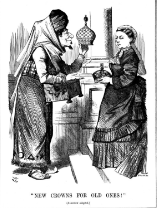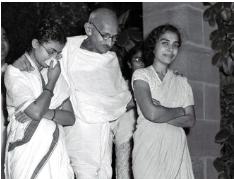India used to be known as “sohne di chiria,” translating from Punjabi to ‘the golden bird’. It was known for its vast expanse of wealth, spices, rich culture and leadership. However, this description does not describe most of what India is today. The British’s slow but systematic colonization wrecked India from its roots. Here is how:
1. Traders to colonists: The British originally came into India as the “East India Company” to trade with India for spices and goods. When they first entered, Indians were speculative of their true intentions. However, after years of gaining their trust they promptly used this as a disguise, and climbed up the ranks and slowly took power all over India.
2. Dilip Singh & the Bloodline of Punjab: Maharaja Ranjit Singh was the great unifying force of the Sikhs. As King of Punjab, he prioritized education and equal rights for all. The last thing the British needed when conquering India was a united Sikhs and a united nation, as Sikhs were the protectors of India. To conquer this problem, they terminated Maharaja Ranjit Singh’s bloodline. Dilip Singh, son of Maharaja Ranjit Singh was separated from his mother Rani Jind Kaur at the tender age of five. Once taken into custody by the British, he was subsequently brainwashed and groomed by British appointed guardians, Mr. & Mrs. Logan, into converting into Christianity and cutting his hair. Maharaja Duleep Singh, at the age of ten, signed the Treaty of Lahore, in 1849 forcing Punjab to renounce all claims of sovereignty. After assimilation into England, Maharaja Dilip Singh was never allowed to go back to Punjab. Interestingly, the rest of Maharaja Ranjit Singh’s children were not able to have offspring to continue the bloodline. Thus, the British effectively suppressed any potential for a united Punjab by eliminating all heir to the throne.
Punch Magazine, 1876, depicting Prime Minister Benjamin Disraeli presenting the crown of India to Queen Victoria (Photo: Ann Ronan Pictures/Print Collector via Getty Images).
3. Harmandir Sahib: After linguistically dividing Punjab, the British set out to take control of the Gurudwaras of India, the source of power for the Sikhs. The Gurudwara Movement of 1921 set out to free all Gurudwaras of British control. Their appointed priests (Mahants) controlled the Gurudwaras at their behest. The Nankana Sahib massacre of 1921 was perpetrated by British appointed Mahant Narayan Das of Nankana Sahib with British connivance. They controlled the Golden Temple Toshakhana, Lahore Darbar Toshakhana and took valuable Sikh articles of faith like Guru Gobind Singh Ji’s sword and original versions of Sri Guru Granth Sahib to England to put on exhibition. The 1921 Gurudwara reform movement finally forced the British out and gave the power of the Gurudwaras keys back, however the Sikhs paid a heavy price.
- 4. Puppet rulers and “peace” activists: It was a common occurrence for the British to bribe small kings into being “puppet rulers.” This was a system used by the British in which they put a placeholder king in the throne, while making all decisions and holding all the power. This was used so constituents would believe they are living freely, but in reality they are still being controlled by the British. This technique was used throughout India as the British began to slowly take control over India in a discreet way. This technique was used across India, and was a key element of their overtaking of power.
During partition, Gandhi became a key player of the British to mislead Indians unhappy with the colonial government into peaceful protesting. Although this method is not fundamentally flawed, it stunted any progress towards resisting the British and being freed from colonial rule.
Gandhi with Abha (left) and Dr Sushilanayar at Birla House in Delhi, 1947 (Photo: India Today).
5. Systematically breaking apart India’s education system: The fundamental core aspect of a culture is their literacy, as this is the way they learn about themselves and what they believe in. The British being aware of this made this the first thing they set out to destroy when they started their conquest of divide and rule. They replaced Indian literature in school curriculums with British literature including works from British authors such as William Shakespeare and Rudyard Kipling. The worst aspect of this change is the effect it will carry on future generations. Now, decades after the British Raj ended, the effects are still in place and the future generations are being taught what the British wanted them to learn, thus India in its post-colonial state is still being controlled by the British. Schools in India have strict policies against speaking Punjabi and Hindi, the native language of many Indians across the country. This detaches the younger generation from its roots, thus serving the British mission. The intent of British colonization was not to “civilize” an already prospering country. It was to fundamentally de-stabilize a country from its core.
6. Replacing tanti saaz with harmoniums (known as the instrument of a beggar): The Sikhs of India before partition practiced kirtan using tanti saaz, complex string instruments native to India. This included Rabab, Sarang, Sitar, Dilruba and Tabla. Many of these instruments were made and given to us by our Gurus. The Crown, looking for methods of destroying Sikh culture, slowly and systematically eradicated these instruments and replaced it with the harmonium - a European beggars instrument - in an effort to cheapen shabad kirtan and take away what the Guru Sahibs have given us. Even in the current Indian film industry, harmoniums are only shown being used by street beggars or in lewd songs. Introducing harmonium was additionally an economic gain for the British. Many parts of the harmonium were only imported from Britain, thus establishing religious reliance on England by the Sikhs.
7. Divide and Conquer: Dividing Indians by religion, class and social standing and pitting them against each other was the key to the overtake of India. This was carefully orchestrated by the British to divide India and keep India divided.
When the British occupied Punjab, they analyzed the population. They were surprised to find that Sikhs were a very small minority of the population of Punjab. Muslims being the biggest followed by Hindus and Sikhs a distant third. From that they understood that the source of resistance against their rule comes from the Sikhs. The Sikh strength comes from Gurudwara and the goodwill and unitedness with Hindus and Muslims. Recognizing the importance of Sikhs, the British set about to weaken the Sikhs in the guise of being allies. They tried to delineate the Muslims and Hindus from the Sikhs: first they inculcated the idea that Urdu is the language of the Muslims and imported it from the United Province (UP) to Punjab. Even though Urdu was alien to Punjab, they formulated the Muslim identity around Urdu. For the Hindus they introduced the idea that Hindi is their language, not Punjabi. The effects of this is still evident today here Hindu Punjabis prefer and Muslim Punjabis in Pakistan prefer Urdu over their own mother tongue: Punjabi. This isolated the Sikhs and expedited the partition and the breakdown of India.
8. Burning libraries and literature: Education as well as literature has high importance in culture. It educates, teaches history, and preserves traditions and values. Destroying literature is the key to preventing future generations from staying connected with their culture and history. The British, well aware of this fact, burned down countless libraries and archives in India during their reign. These included hand written manuscripts, religious texts, and rare books. They went as far to destroy the Rani Jhansi Library, as well as many other libraries. This is not the first time this tactic was used. Similar to the Mughal Raaj during the holocaust, Jewish libraries and books were burned in an attempt at ethnic cleansing and eradication of all Jews. When Punjab was under the rule of Maharaja Ranjit Singh ji, Punjab’s literacy rate was 100%. He created booklets with the Punjabi alphabet and numbers so everybody could be literate no matter their age, gender, or occupation.
Destabilizing a prospering society requires certain key aspects: eliminating history, knowledge, culture, and unity. Through the careful and systematic division the British established during their colonial hold, they effectively were able to pit neighbors against each other. Through the careful use of divide and conquer the British successfully destabilized India from its core; its brutal effects still present in today’s Indian society and culture.



